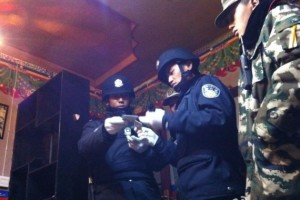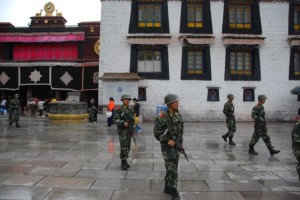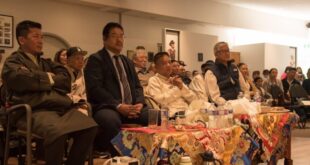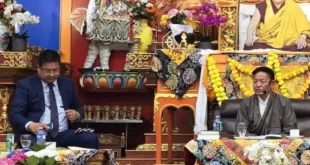Checkpoints with fire extinguishers, pincer-wielding police officers, and spies disguised as monks—welcome to daily life in Lhasa.
Anastasia Corell
The Atlantic
Dec 13 2013
From nearly any point in Lhasa, capital of China’s Tibet Autonomous Region, you can see at least two police checkpoints.

At each one, police officers stand by, wielding a metal pincer devised for handling people who are on fire. The pincers consist of a pole, approximately six feet in length and with a large hook or hoop at the end, and allow policemen to seize burning protestors by the waist or neck. The devices, which resemble an oversized surgical instrument, are intended to deter any would-be protestors by ensuring that they can quickly be subdued and concealed.
Large military trucks drive down the streets of Lhasa in groups of two, often accompanied by armored police vans that double as holding cells. In a city famous for its exotic, otherworldly charm, the police presence is jarring.
Ever since the People’s Republic of China established control over Tibet in 1951, Beijing has viewed the territory as a major security risk due to periodic ethnic unrest. In 2008—the same year the Beijing Olympics served as a symbol of Chinese renewal—an uprising in Lhasa resulted in a crackdown that has left this city in an effective state of martial law ever since.
For foreign visitors, travel to and within Tibet is heavily restricted. Arriving alone is not allowed, and pre-approved tourist groups must present passports and permits in order to enter. At entry points, security personnel—uniformed soldiers and riot police armed with weapons and fire extinguishers—stand on alert and stare visitors down with an intensity unusual elsewhere in China.
Within Lhasa, tourists caught taking a picture of a police checkpoint are immediately approached and ordered to delete it. Even visitors on organized tours attract scrutiny: At the Ganden Monastery just outside of the city, policemen reported our group’s positions to each other on walkie-talkies, unaware that we could speak Chinese. Closed-circuit video cameras—high-tech, 360-degree-view devices mounted on horizontal beams that resemble streetlights—blanket Lhasa’s streets. These, at least, are an improvement over what used to be there: rooftop snipers.
***
The Chinese government claims that Tibet has been an integral part of China since the Yuan Dynasty invaded the territory in the 13th Century. For much of the ensuing centuries, Tibet, though received in Beijing as part of successive Chinese empires, was not subject to the same laws. After the Qing dynasty fell in 1911, Tibet established diplomatic relations with other countries and was largely separated from the turmoil within China until the Communists arrived in 1951.
In 1959, following a failed uprising, The Dalai Lama fled across the border to India, from where he has led the Tibetan government in exile ever since. Over the years, as he became an international icon, The Dalai Lama has moderated his political demands: He no longer wants independence for Tibet but simply greater autonomy. Nevertheless, the Chinese media still assails him as a “wolf in sheep’s clothing,”—a separatist unworthy of Tibetan adulation. Images of the Dalai Lama have been banned in the region since 1996.
The conventional Chinese belief toward Tibet is that the Communist Party liberated Tibetan people from an oppressive, feudal government under the Lamas and, through development, have improved their material welfare and provided them with opportunities in the modern world. Beijing’s investments in the territory are substantial: In 2011, China announced a five-year plan that includes $21.4 billion in infrastructure projects such as road, rail, and hydropower. Tibetans argue that these improvements have come at a great cost to their culture and way of life, and that the migration of Han Chinese settlers—lured by government incentives—is turning once-traditional Lhasa into an ordinary Chinese city.
Tibet’s strategic importance to China is great. The territory is the source of Asia’s most important waterways, including the Yangtze, Yellow, and Mekong Rivers, which irrigate China’s fertile central plain and most of Southeast Asia. It also serves as a buffer between the country and an emerging rival, India. Beijing feels that any compromise with Tibetans would encourage separatist movements elsewhere, particularly among the Uighur population in China’s far-west Xinjiang region. It is essential to China’s domestic security that Tibetans come, eventually, to regard themselves as Chinese.
Meanwhile, the Tibetans have grown increasingly desperate. Over the last two years, tensions have led to a spike in self-immolations, resulting in over 120 deaths, and the possibility that people may set themselves on fire explains Lhasa’s tense police presence. In Jokhang Square, the physical center of ancient Lhasa and a holy Buddhist pilgrimage site, soldiers carry fire extinguishers instead of guns. At gas stations, everyone must register and report exactly how much gasoline they take, and to which destinations. The government monitors siphoning—after all, it may be a possible prelude to self-immolation.
Religious sites offer little respite. In the dim, incense-filled halls of monasteries, military police in orange fire-resistant jump suits stand against the walls while monks chant in prayer. The monks themselves are not entirely trustworthy—the Chinese government has planted spies disguised as monks in important Tibetan monasteries, while others cooperate with the police.
***

But the dominant aspect of life in Lhasa remains the checkpoints. Some consist of a folding table with two security guards, squeezed in between shops on a crowded street. Others are large pre-fabricated buildings that host teams of Chinese police and are equipped with riot gear including helmets, shields, and fire blankets. Checkpoints on Lhasa’s major roads are surrounded by knee-high spiked metal barriers, protecting the buildings from vehicles.
Leaving the city by car, the checkpoints appear on the highway nearly every half hour. At one of these stops, our Tibetan driver encountered an old friend inspecting papers, a rare sight in a place where authority figures are almost entirely Chinese. Even so, the inspector spoke to his fellow Tibetans in Mandarin. Our guide explained that the inspector had attended college in China—his only chance for a decent job—and now acted more Chinese. “They come back brainwashed,” he said.
In July 2011, now-president Xi Jinping visited Lhasa in his role as vice president, handing out solar-powered lamps inscribed “Celebrating 60 years of Tibetan liberation.” The lamps were a hit in rural Tibet—a region with sporadic access to electricity—and they quickly became known, sarcastically, as “Xijinpings.”
This exchange epitomizes Beijing’s position on Tibet: The Communist Party regularly works to improve the well being of its poorest people. Yet do the Tibetans themselves feel this way?
At the China/Nepal border, I asked a Tibetan friend what he thought would happen to his homeland.
“It will all be gone soon, it will disappear. I think we will all just die out, and there is nothing we can do about it.”




